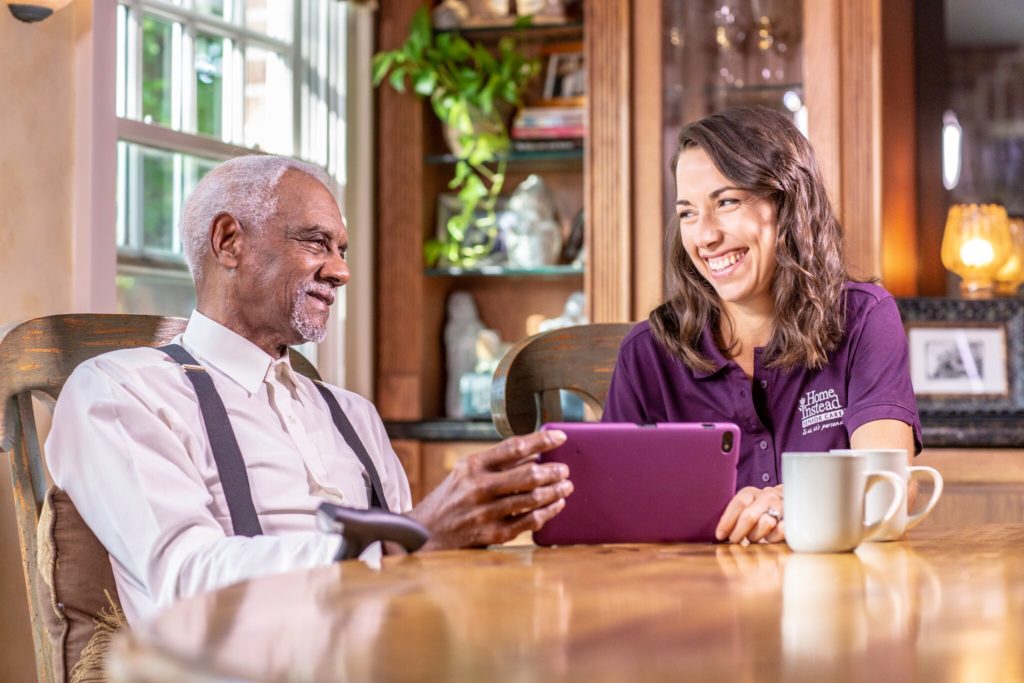Home Instead Inc. — the international franchise company behind the Home Instead Senior Care network — is joining forces with senior-friendly tablet startup GrandPad in an attempt to reduce client loneliness and improve connectivity.
As part of the new partnership — announced Tuesday — the Omaha, Nebraska-based home care franchiser has also made a “significant” minority investment in GrandPad, Home Instead President and CEO Jeff Huber told Home Health Care News. It’s the first major technology play for Home Instead, which boasts nearly 1,200 independently owned and operated franchise locations across the U.S. and a dozen other countries.
“We’ve been looking at the macro picture and understanding where technology is going in the aging space,” Huber said. “We’ve been looking for the right solution for many, many years to bring together high-tech capabilities with our high-touch approach to caregiving.”
Huber declined to comment on the exact size of Home Instead’s investment into GrandPad, which has raised more than $15.7 million since launching in 2014, according to online funding tracker Crunchbase. In addition to Home Instead, Orange County, California-based GrandPad’s investors include computer giant Acer and Consumer Cellular, which offers cell phones, no-contract service plans and related accessories with a focus on consumers 50 and older.
The result of roughly a year’s worth of conversations, the partnership with Home Instead immediately opens new doors for GrandPad, with Home Instead planning to implement the startup’s technology across the majority of its operations within the next few years.
“Our goal when I started the company with my co-founders was to one day reach millions of seniors around the world,” GrandPad CEO Scott Lien told HHCN. “This really accelerates that.”
Innovation, scale and social determinants of health
Along with the equity investment, Huber has also been added to GrandPad’s board of directors, where he will help steer the startup moving forward.
“The board seat gives me a great view into the operations in terms of helping to steer and weigh in on GrandPad’s roadmap,” Huber said. “It was time for us to make a significant investment in technology and bring on a trusted partner — and we wanted to have a deeper relationship rather than just a vendor relationship.”
A number of Home Instead offices began incorporating GrandPad’s technology in the fourth quarter of 2018, learning how to position the tablet and understand its capabilities for clients and caregiver alike. The number of participating offices is set to grow in Q1 2019, with the goal of “hitting the scale button” toward the middle of the year, Huber said.
Initially, Home Instead plans to leverage the GrandPad tablet by enhancing the care delivered in the home. Over time, the franchise company hopes to use the tech to offer entirely new services, such as interactive remote care, something that can strengthen Home Instead’s caregiving capabilities among underserved populations and in rural areas.
“We’re starting with what we call ‘integrated care,’ which is incorporating GrandPad into caregiving services, bringing it into the home with our professional caregivers,” Huber said. “Right now, there’s an enormous caregiving demand. We frankly can’t meet the demand, but technology should allow us to scale things.”
Currently, Home Instead largely operates on a one-to-one relationship between caregiver and client.
In particular, GrandPad has the potential to make an impactful difference in mitigating senior isolation and loneliness, Huber said. Senior isolation and loneliness are two of the top social determinants of health many health and managed care organizations are seeking to address.
Nearly three in 10 adults over the age of 40 feel socially isolated, according to AARP.
Technology adoption among older adults
GrandPad designs its tablets specifically for older adults. To do so, it gathers input from its in-house senior employees, who range in age from 84 to 104, Dr. Kerry Burnight, chief gerontologist at GrandPad, told HHCN.
That input has allowed GrandPad to build a tablet with few points of friction for its users. Users don’t have to deal with difficult-to-remember passwords or device charging reliant on small wires, which may be tough to maneuver for older adults with reduced dexterity levels.
“We have an extensive group of seniors testing every day, identifying what is going to work and what their preferences are,” Burnight said. “And [the GrandPad tablet] isn’t dumbed down in any way. It’s the most sophisticated technology you can have in its simplicity, in its user-friendly interface in hardware, software and customer service.”
Secure video chatting, voice-enabled emails, photo sharing and games are among GrandPad’s features. One of the biggest draws to GrandPad, however, is its built-in and unlimited 4G LTE internet access.
About half of all seniors say they have high-speed internet access at home, according to the latest senior technology report from the Pew Research Center. When Pew began tracking internet adoption in early 2000, just 14% of seniors reported being internet users.
While not a direct comparison, statistics highlighting smartphone adoption by older adults provides added perspective when it comes to broader device use. Slightly less than 60% of 65- to 69-year-olds own smartphones, according to Pew, but that drops to 49% among 70- to 74-year-olds, then to 17% among those ages 80 and older.
Smartphone ownership is highly correlated with household income and educational attainment.
GrandPad’s estimates that its addressable market in the U.S. is over 5 million people, Lien said. So far, “tens of thousands of people” have begun using its tablet, helping GrandPad to see year-over-year revenue growth of more than 300% in 2018 compared to the previous year.
“It’s basically hockey-stick growth now,” Lien said, noting that GrandPad is not pursuing similar arrangements with other players in the aging services arena. “This is a huge opportunity for us with Home Instead’s reach. They serve so many people, so it’s the right place for us to stay focused.”
Home Instead locations provide more than 70 million hours of care annually.




